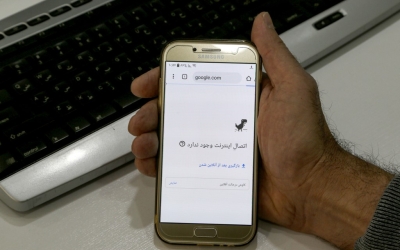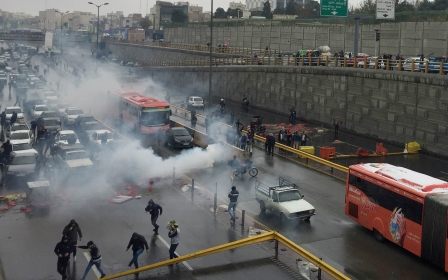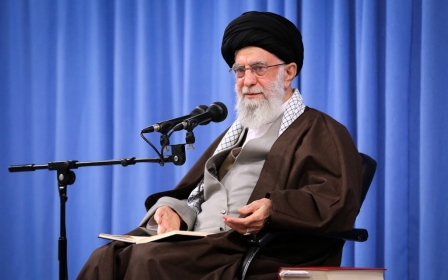Iran’s petrol protests: How they broke out and what comes next

Country-wide protests erupted across Iran on Friday, a day after the government announced a sharp hike in petrol prices.
The abrupt decision included a rationing scheme and a slashing of subsidies that led to prices soaring by at least 50 percent.
In order to contain the demonstrations and thwart civil collective organisation, the state enforced “a near-total national internet shutdown” across the country.
According to the most recent reports, at least 12 people have been killed and over 1,000 detained. Other reports put the overall death toll as high as 36 across the nation.
The trigger
The decision to raise petrol prices was made by the Supreme Council of Economic Coordination (SCEC), a powerful contingency body formed on Supreme Leader Ayatollah Ali Khamenei’s orders following the US withdrawal from the nuclear deal in May 2018 and the re-imposition of crippling sanctions.
The SCEC is made up of the heads of government branches, namely President Hassan Rouhani, Parliament Speaker Ali Larijani and Chief Justice Ebrahim Raisi.
Even though the Rouhani administration, much like previous governments, has backed the reduction of state fuel subsidies as a necessary means to reform the economy, the measure was adopted at a higher level of authority and without prior notice.
This indicates an urgent need to address Tehran’s deepening budget deficit caused by its hampered ability to export crude due to the US oil and banking sanctions.
The new policy was agreed upon and adopted so hastily that even MPs were mostly in the dark about it.
One MP went as far as to sarcastically recommend shutting down parliament, therefore saving money on its expenses and helping with the “resistance economy”, a name for the cost-saving measures consistently promoted by Khamenei.
Iran’s annual government budget for the current Persian year (21 March 2019 - 21 March 2020) was predicted on oil sales of around 1.5 million barrels per day (bpd), whereas market studies today show a much smaller crude export rate of 100,000-500,000 bpd.
Meanwhile, according to the International Monetary Fund (IMF), the Iranian economy is expected to shrink by 9.5 percent this year, 3.5 percent more than a previous forecast of 6 percent contraction. Tehran would need petroleum priced at $194.6 a barrel to balance its budget next year, the IMF says. Currently, a barrel of oil is sold at around $62.
The government’s neoliberal tendencies coupled with the political composition of the SCEC - a moderate president, a pragmatist parliament speaker allied with Rouhani, and a hardline judiciary head at odds with both - helped create the impression that it was primarily the administration rather than the whole political establishment that spearheaded the petrol price spike policy.
According to a Tehran-based intelligence analyst affiliated with the Islamic Revolutionary Guards Corps (IRGC), this is exactly the opposite of what Rouahni and his allies have sought to do ahead of next year's parliamentary elections.
'The Rouhani-allied moderates have taken people’s livelihoods hostage, and are seeking to undermine the establishment in the hope of resuscitating themselves politically'
- Intelligence analyst
“The Rouhani-allied moderates have taken people’s livelihoods hostage, and are seeking to undermine the establishment in the hope of resuscitating themselves politically,” the analyst told Middle East Eye, speaking on condition of anonymity.
Shortly before the new petrol price announcement, Rouhani staged a rare public tirade against the hardliner-dominated judiciary for what he described as its discriminatory and politically motivated crackdown on alleged corruption.
In response, almost all hardline media outlets and officials, including senior IRGC commanders and influential clerics, lashed out at the Rouhani administration, accusing it of unmeasured and imprudent attempts to win political points.
Despite the accusations and criticisms, it is noticeable that the top Iranian leadership did not intervene to prevent the price hike despite the highly combustible situation in Iranian society today and predictions of massive popular backlash.
Khamenei’s support
One reason touted for the ruling establishment's failure to intervene is that it may have anticipated that popular anger would be directed at the already embattled moderates and knock them out of relevance once and for all.
“The most significant point about the new petrol policy is that it was implemented without any efforts to prepare the public opinion for the shock,” said Hamidreza Azizi, assistant professor of political science at Shahid Beheshti University in Tehran.
“Considering how hardline media covered the story, powerful hardliners seem to have been seeking to further enervate the Rouhani administration and portray moderates affiliated with it as essentially ineffective and misguided.”
Except that it was a miscalculation.
'The most significant point about the new petrol policy is that it was implemented without any efforts to prepare the public opinion for the shock'
- Hamidreza Azizi, political scientist
Popular demonstrations against the decision broke out the next day in several cities across Iran, but they did not remain limited to outcries against the petrol price spike specifically.
In fact, they developed into protests against the whole political establishment and its policies at home and abroad, accused of massively contributing to the deterioration of living conditions for the majority of Iranians.
One recurring theme in the protests attracting particular controversy is an opposition to the Islamic Republic’s longstanding financial and logistical support for paramilitary groups in the region.
According to official statistics, up to 40 percent of Iran’s 83 million population fell below the “poverty line” last year. The economic circumstances have further deteriorated since.
Khameini himself has said the fuel price hike was done with his blessing.
“I am not an expert [on the issue] and there are different opinions, but I had said that if the heads of the three branches make a decision, I will support it,” he said on Sunday.
The supreme leader also blamed the unrest on the Islamic Republic’s foreign foes and anti-revolutionary groups, urging security forces to contain the protests.
“Some people are no doubt worried by this decision... but sabotage and arson are done by hooligans, not our people. The counter-revolution and Iran’s enemies have always supported sabotage and breaches of security and continue to do so,” he said.
Predictably, Washington has pounced on the protests, with Secretary of State Mike Pompeo tweeting: “As I said to the people of Iran almost a year and a half ago: The United States is with you.”
While the protests may appear a boost for the US' "maximum pressure" strategy against Iran, the Islamic Republic leadership's response tells a different tale.
Ever since the US pullout from the nuclear deal in May 2018 and restoration of draconian sanctions against Tehran, the Iranian leadership has been extremely careful not to greenlight measures that might give an impression of weakness and submission to pressure.
For Khameini, showing any kind of flexibility would give oxygen to the idea that Washington's policies are working and causing change.
As the Iranian government's refusal to back down in the face of growing popular dissent shows, the US “maximum pressure” strategy can yield contradictory and counterproductive results.
This article is available in French on Middle East Eye French edition.
Middle East Eye propose une couverture et une analyse indépendantes et incomparables du Moyen-Orient, de l’Afrique du Nord et d’autres régions du monde. Pour en savoir plus sur la reprise de ce contenu et les frais qui s’appliquent, veuillez remplir ce formulaire [en anglais]. Pour en savoir plus sur MEE, cliquez ici [en anglais].






